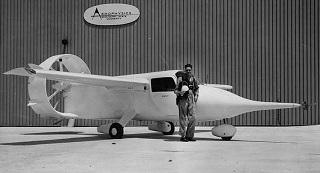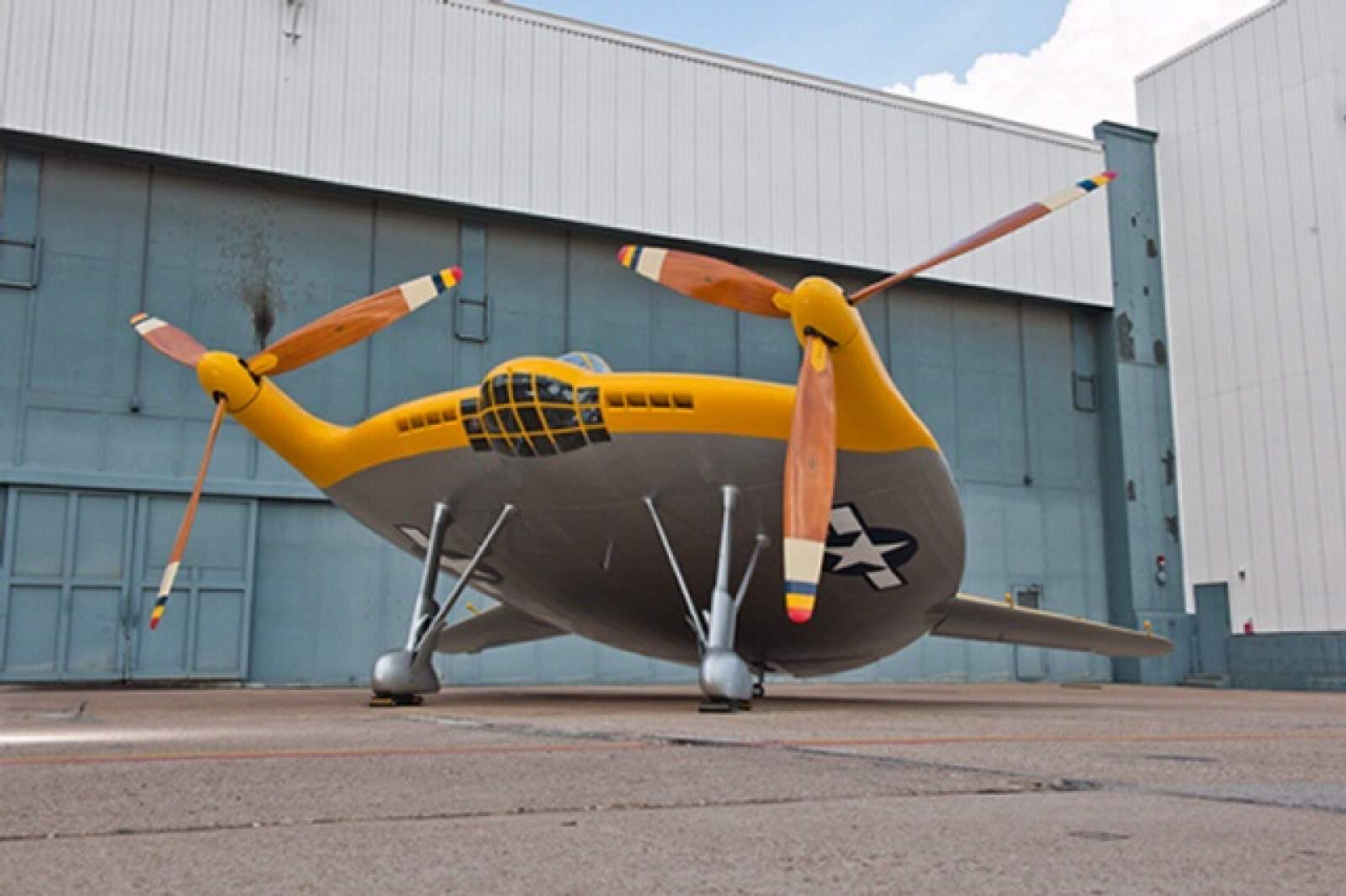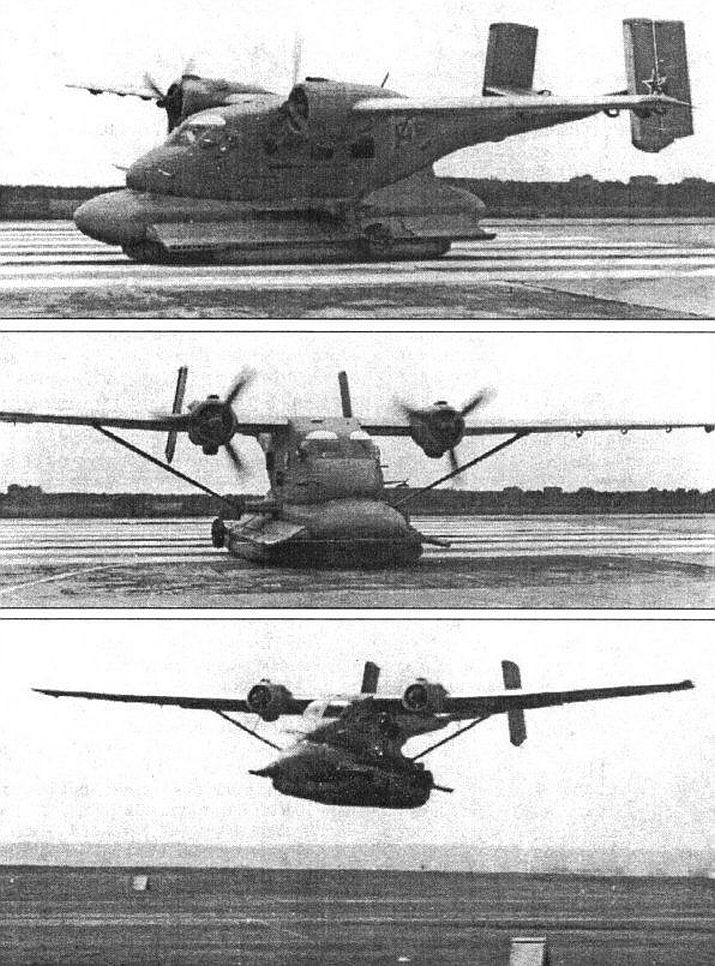10 Weird Aircraft

Here are ten monstrous flying machines that had they voices would have probably rasped, “master, why did you create me?”

9. Bartini Beriev VVA-14 (1972) ‘Millenium Balkan’

Robert ‘Ludvigovich’ Bartini was an aristocratic Italian aircraft designer. The Italian Communist Party sent him to the USSR following the Fascist take-over of Italy. It was the intention of the ICP that he would bring modern Italian know-how to the Soviet aviation industry to aid its fight against fascism.

Being an aircraft designer was an extremely dangerous occupation in Stalin’s terror state, being a foreign aircraft designer even more perilous. In 1938 Bartini began an eight year prison sentence. Despite spending the Great Patriotic War imprisoned, he still did a huge amount of design work, notably on the Tu-2 bomber.

Bartini also proposed the A-57, a long-range strategic bomber that could land on water and refuel by submarine.
He became one of the most important Soviet aircraft designers, and survived to design the exceptionally unusual VVA-14, designed to counter the threat of Polaris missile submarines. This was a wing-in-ground-effect vehicle, a type of aircraft which sits on the recirculated air that forms beneath wings at extremely low altitudes. Capable of taking off from land or water, the vehicle could fly far faster than any boat at ultra low-level while carry large loads. It could also fly at higher altitudes as a true aeroplane.

In collaboration with the Beriev Design Bureau, Bartini planned to develop the prototype VVA-14 in three phases. The initial M1 was to be an aerodynamics and technology testbed. The M2 would have a battery of 12 Rybinsk RD-36-lift engines to give full VTOL capability, and was to be fitted with one of the world’s first fly-by-wire flight control systems. The M3 would integrate weapons (including depth charges, torpedos and anti-shipping missiles), the Burevestnik computerised anti-submarine warfare (ASW) system and the huge Bor-1 magnetic anomaly detector (MAD).


Bartini died in 1974 and with him the momentum that drove the project. Like all Ekranoplans, being neither fish nor fowl no one quite knew what to do it with it and the the VVA-14 never entered service.

8. THK-13 Flying Wing Glider ‘Turkish Spirit’

Not outright weird but definitely an unorthodox design for its time. From an unexpected country with little or no background in aircraft production, the THK-13 flying-wing glider deserves to be on this list.
Met with harsh criticism for its looks, the THK-13 glider was a product of Turk Hava Kurumu (THK – Turkish Air Association), the aviation bureau of the young Turkish Republic. THK was established in 1925, only two years after the foundation of the republic itself. THK quickly set up a production facility and trained a core engineering team. It created several aircraft and glider programmes from the THK-1 to the THK-16. Of these, the THK-5 twin engine light transport and THK-15 two-seat trainer were the most successful.

The THK-13 design work was started in 1943 by senior engineer Yavuz Kansu. The prototype made its maiden flight on 26 August 1948 in Ankara, and was towed into the air by a Focke-Wulf Fw 44. During take-off, the towing cable ripped off and the glider went out of control, resulting in an emergency landing in a nearby field. The pilot, Kadri Kavukcu, survived without a scratch — and the prototype was quickly repaired in the field. Several hours later, it made another ‘first flight’, again towed by the Fw 44. This time landing safely back at the THK airfield.
Upon the news of the crash, local media jumped on the opportunity to blame THK for designing such a ‘weird’ aeroplane, speculating that such an unlikely looking machine was sure to fail. The project was shelved until the next year. A flight on 29 September 1949 ended in a more severe crash, seriously wounding the pilot and sealing the fate on this extraordinary glider.
You can find more unusual flying machines here.

Enter a caption
7. Mississippi State University XV-11 MARVEL ‘The Marvel Superfan’
Looking like it flew straight through a wind tunnel taking the fan with it, the first all-composite aircraft was the Mississippi State University XV-11 MARVEL. MARVEL is a backronym standing for ‘Mississippi Aerophysics Research Vehicle with Extended Latitude’. The aircraft was build to continue research for the military into boundary layer control, an effort that had been ongoing since the 1950s. Accordingly, the MARVEL employed a blower driven by the engine to draw suction through more than one million tiny holes in the wings and fuselage.  The aircraft also spurned conventional flaps in favour of wing warping to deflect the wing trailing edges. So far, so weird, but the good people of the Department of Astrophysics and Aerospace Engineering at the Mississippi State University weren’t stopping there and added a ‘Pantobase’ or ‘rollerboot’ undercarriage with tandem wheels fitted within two sprung wooden pontoons which were intended to allow operations from rough surfaces or water.
The aircraft also spurned conventional flaps in favour of wing warping to deflect the wing trailing edges. So far, so weird, but the good people of the Department of Astrophysics and Aerospace Engineering at the Mississippi State University weren’t stopping there and added a ‘Pantobase’ or ‘rollerboot’ undercarriage with tandem wheels fitted within two sprung wooden pontoons which were intended to allow operations from rough surfaces or water.
The ducted pusher propeller returned with little success in the Edgely Optica and RFB Fantrainer.

The technologies of the XV-11 were first tested on the Mississippi State University XAZ-1 Marvelette of 1962
6. Tumonecotrans Bella 1, Russia (1994) ‘The Swamp Monster’

Our initial efforts revealed that Google video searches for ‘Trans Bella’, while distracting, are not helpful for researching rare Russian aircraft. What was useful however, was an ancient Russian website looking for investors in an utterly bizarre form of transportation.
The story starts in the Soviet Union in 1989. Alexander Filimonov wanted to build an aircraft that could operate from the Arctic regions, Siberia and the far east of Russia without airfields. According to the aforementioned (and extremely quaint) website “70% of aircraft maintenance costs in this region relate to airfields”.

On the other hand there are numerous natural flat airstrips in the form of lakes, rivers, marshes and fields. But even a rugged seaplane will struggle with marshes, and a helicopter or aeroplane needs special adaption (and a brave pilot) to operate from very thick snow or long grass. As the company’s website notes, “For example, the well-known Russian An-2 aircraft has three changeable takeoff and landing devices: wheel, ski and hydrofloat. The first two require runways.”


So how could an aircraft deliver cargo or people to such austere locations? Filimonov believed the answer was to combine the advantages of a ‘wing-in-ground’ effect ekranoplan with a conventional aeroplane. The result is a strange hybrid, with a horizontal ducted helicopter-like fan, a hovercraft-like ‘skirted donut’ – and pusher engines and wings. Here was a machine that could make very short take-off from extreme terrain, and do it in terrible weather conditions. Funding was never found for this extremely unusual project.

Sadly, this site will pause operations if it does not hit its funding targets. If you’ve enjoyed an article you can donate here.
5. Vought V-173/VF5U ‘Zimmers Skimmer’

The handsome Vought XF5U

In the 1930s, Charles H. Zimmerman advocated the ‘discoidal’ aircraft with its pancake-shaped fuselage acting as a lifting surface. Zimmerman had worked on NACA’s (later renamed NASA) early wind tunnels. Influenced by the circular designs of Cloyd Snoder, and the less ridiculously named Steven Nemeth and Richard Johnson, he took this concept a step further. He wanted to produce a circular VTOL aircraft capable of flights at unbeatable speeds and altitudes, and able to hover like a helicopter. This proved overly ambitious with contemporary technology, but earned Zimmerman a prestigious NACA award. 
Zimmerman believed that discoidal aircraft could be capable of near vertical take-off and landings. They also promised excellent manoeuvrability, high speed and great structural strength.
The concept, nicknamed the ‘Zimmer Skimmer’, was radical and unlikely- so Zimmerman set about demonstrating its veracity with a series of prototypes for both himself and the Vought company. The V-173 flew in 1942. Soon local residents were reporting UFOs, or they would have if the term existed (‘UFO’ was coined in 1953 by USAF). Nazi sympathiser and general douche Charles Lindbergh flew the type and found it handled extremely well, especially at low speed. Initial problems were centred more around the propulsion system, which used a complex geared system to route power to the propellers from the engine than the novel aerodynamic configuration.
One propulsion failure led to a dramatic emergency landing on a beach. As the aircraft landed the pilot spotted two utterly bewildered bathers in the aircraft’s path. Full braking effect was applied, resulting in the aircraft somersaulting over on itself. Thanks to the aircraft’s immense strength both the pilot and aircraft emerged unscathed.

Before the V-173 had flown, Zimmerman was working on its weaponised successor, the the Vought XF5U ‘Flying Flapjack’ for the US Navy. Fast, agile, well armed (six 50 cals or four 20mm cannon) and with a tiny take-off run the aircraft was a tantalising prospect as a carrier fighter. The geared propulsion system again proved troublesome, as did repeated operation of piston-engines and very large propellers at very high angles of attack. Development dragged on, and the war ended.
By 1947 the XF5U-1 was finally ready to fly. But propellers were passé, Vought was busy moving to Dallas and the ‘Pancake’ had run out of luck. Unusually, the US Navy ordered the aircraft be reduced to scrap. Vought’s chief test pilot Boone Guyton had been looking forward to flying the aeroplane and was extremely upset by this wanton destruction. He tried to physically stop the wrecking crew, but failed. The wrecking ball took a long time to destroy the immensely tough airframe, but eventually succeeded.
After it was destroyed and sent to the scrapheap someone remembered that the gearbox contained $6000 ($71,713 in 2020 dollars) worth of silver. Staff and security personnel scoured the scrapheap but failed to find the missing silver. Eventually the local scrap dealer who had hauled the wreckage away was caught by the FBI trying to sell the silver. But as Vought had made the mistake, it was found that the dealer’s actions were completely legal. The dealer kept the silver, and Vought was forced to pay back the Navy.

The German AS-6 V-1 was a wartime effort by Arthur Sack. It is likely that Sack was influenced by the worker of Zimmerman.

4. Antonov An-14SH ‘Clodhopper’

The West believes the world should adapt to support its aeroplanes, whereas the Soviet Union believed the aeroplane should adapt to function in the world as it is.

The Antonov An-14 was a small tough short take-off and landing transport. It was intended to replace the hugely popular An-2 biplane, the only problem being that the An-2 was still doing its job very well and didn’t need replacing. Antonov gave up after only 332 units – which is small potatoes compared to the 18,000-plus An-2s. Perhaps as a punishment for lack of success, Antonov used the unlucky type for multiple experimental purposes. On January 22 1983, one aircraft took the sky with the indignity of a hovercraft undercarriage. This would have allowed the An-14Sh to have taken off or landed from any flat (or almost flat) surface from rivers to bumpy fields. The huge drag and reduction in range and payload were unacceptable and the project did not carry only beyond the prototype stage though the idea may have influenced the later Bella 1.


If you’re a multimillionaire and you want a new private jet, you have many obvious if slightly unadventurous choices. Textron, Dassault, Bombardier, Gulfstream or Beechcraft will be happy to sell you a sleek, safe and refined jet that will perfectly fit any brief. If you’re feeling a bit quirky, you might even take a look at Pilatus and their PC-12, or maybe the stiletto-inspired HondaJet.

But if you’re not just a run of the mill multimillionaire, you’ll want a jet which will stand out on the apron when you fly into Samedan for a spot of snow polo. In that case, there’s only really one choice. The wonderfully weird Piaggio Avanti P.180.


Piaggio also used pusher propellers on P.166 which made an appearance in the 1960 film Plein Soleil
Ok, from some angles it’s a bit carp-like, but most of the time the Avanti gives off strong Thunderbirds-meets-Flight of the Navigator vibes. The fact that the turboprop engine and its propellers point backwards, the third, anhedral lifting surface at the front, the wing shaped fuselage, the T-tail and massive delta fin strakes, the scimitar shaped blades in the latest EVO version… it all adds up to something a child of the 60s would have imagined we’d all be flying around in today. Jeff Tracy would have definitely flown in an Avanti to get to and from Tracy Island.

P.7
Perhaps it’s not surprising that the Avanti is so different, because Piaggio has a history of making decisions against the grain. First, there was the P.2, an aerodynamically clean monocoque, low wing monoplane which flew in 1923, when most other manufacturers were busy bracing the wings of their biplanes with wires. But Piaggio’s place in the heritage of weird planes is assured by the P.7, an amphibian racer built to compete in the famous 1929 Schneider Cup Race, which forced designers and manufacturers to make ever more low drag designs and liquid-cooled engines, inspiring the Spitfire and the P-51 Mustang.

The P.7 had a streamlined and stunningly beautiful look, and to avoid the drag and weight of floats, it used hydrofoils to take off from the water. To make it “work”, the Italians came up with a very convoluted take-off procedure. To reach the speeds needed to attain lift on the hydrofoils, the P.7 had a water propeller at the back as well as an airscrew up front. Once the hydrofoils lifted the aircraft out of the water, a clutch would be engaged and switch the power to the front. It was an utterly mad idea and it never got airborne, but without that adventurous heritage which inspired the Avanti, the world of private aviation would be a lot more boring.
2. Avro Canada VZ-9 Avrocar ‘The Malton Saucer’ (1959)

Wobbling drunkenly into this house party of weirdos, our next guest is a two-
place, triple-jet, circular wing, VTOL concept demonstrator with a special take on aerodynamics. A secretive joint undertaking of the Canadian government, Avro Canada, the US Army and the USAF from the late 1950s the Avrocar was a mid- century effort to embrace a scientific principle called the Coanda effect. This is the Bernoulli-like business of deliberately bending a jet of air flowing over a curve to generate controllable lift. In other words, the Avrocar is the silver, convex-bodied aerospace equivalent of Theremin music.
Bench testing and wind tunnel findings aimed at further harnessing Coanda theory remained inconclusive in the mid-1950s after some interest in the 1930s and 1940s. Everything from flying jeeps mounting recoilless rifles to big supersonic NORAD interceptors were briefly envisioned using this handy principle and a circular wing.

This being that gilded era of fabulous prototypes money was available to be thrown at a Coanda-based project, though not the CF-105 Arrow, apparently!
The result does look pretty cool to our jaded 2020 eyes, a throwback to shiny,
imagined futures long given up on. Unhappily, the gyroscopes of the day couldn’t regulate the Avrocar’s tendency to pitch and roll without constant pilot input. A t-tail and other modifications designed to further refine and direct airflow lent only minor improvements to controllability. Wheels were added in place of fixed circular moon lander style feet because the Avrocar couldn’t transition safely out of ground effect. It was only nominally safe in untethered flight at all and right away those two lovely plastic bubble canopies were replaced on the first example with racing car style roll bars at the cockpits. Luckily, the domes remained on the example sent to NASA’s Ames Research Center in California and which you can see at the National Museum of the United States Air Force.

The Coanda effect was never harnessed well enough here to eliminate the dinner plate hanging from a string effect visible in film footage of the Avrocar taken outside
Avro’s plant in Malton, Ontario. Helicopters, STOL aircraft, hovercraft and motor
vehicles were already doing more than the Avrocar ever would. Perhaps some day composite materials and digital flight controls will combine to unweird the circular ducted flow wing and truly unleash the Coanda? We can only hope.

– Stephen Caulfield
- British Rail Flying Saucer (1970)

British Rail, the much missed national rail service, couldn’t make a decent sandwich – but that didn’t stop them flirting with interplanetary nuclear fusion powered flying saucers. Simply squirt liquid fuel beneath the aircraft, ignite it with a series of lasers, create a nuclear fusion explosion and contain the highly radioactive explosion within a magnetic field. Then you can take 22 people to the moon (probably sustained on terrible sandwiches squeezed from toothbrush tubes). Unsurprisingly this radical patent was seen as a being rather too ambitious, but who knows, perhaps one day science will catch up with the imagination of Charles Osmond Frederick, a 1970s locomotive engineer.
You can find more unusual flying machines here.

We launch our new beautiful book!

“If you have any interest in aviation, you’ll be surprised, entertained and fascinated by Hush-Kit – the world’s best aviation blog”. Rowland White, author of the best-selling ‘Vulcan 607’
I’ve selected the richest juiciest cuts of Hush-Kit, added a huge slab of new unpublished material, and with Unbound, I want to create a beautiful coffee-table book. Here’s the book link .

I can do it with your help.

From the cocaine, blood and flying scarves of World War One dogfighting to the dark arts of modern air combat, here is an enthralling ode to these brutally exciting killing machines.
The Hush-Kit Book of Warplanes is a beautifully designed, highly visual, collection of the best articles from the fascinating world of military aviation –hand-picked from the highly acclaimed Hush-kit online magazine (and mixed with a heavy punch of new exclusive material). It is packed with a feast of material, ranging from interviews with fighter pilots (including the English Electric Lightning, stealthy F-35B and Mach 3 MiG-25 ‘Foxbat’), to wicked satire, expert historical analysis, top 10s and all manner of things aeronautical, from the site described as
“the thinking-man’s Top Gear… but for planes”.
The solid well-researched information about aeroplanes is brilliantly combined with an irreverent attitude and real insight into the dangerous romantic world of combat aircraft.
FEATURING
- Interviews with pilots of the F-14 Tomcat, Mirage, Typhoon, MiG-25, MiG-27, English Electric Lighting, Harrier, F-15, B-52 and many more.
- Engaging Top (and bottom) 10s including: Greatest fighter aircraft of World War II, Worst British aircraft, Worst Soviet aircraft and many more insanely specific ones.
- Expert analysis of weapons, tactics and technology.
- A look into art and culture’s love affair with the aeroplane.
- Bizarre moments in aviation history.
- Fascinating insights into exceptionally obscure warplanes.

The book will be a stunning object: an essential addition to the library of anyone with even a passing interest in the high-flying world of warplanes, and featuring first-rate photography and a wealth of new world-class illustrations.

Rewards levels include these packs of specially produced trump cards.



I’ve selected the richest juiciest cuts of Hush-Kit, added a huge slab of new unpublished material, and with Unbound, I want to create a beautiful coffee-table book. Here’s the link to pre-order your copy.


Back in 1920’s-1930’s Turkey was not “an unexpected country with little or no background in aircraft production” Turkey gave up building planes after NATO membership and Marshall Plan. Turkey used and maintained many planes before and during WW1 and during the war of independence. After the fall of Ottoman Empire and Birth of the Republic, both government and private establishments built plane factories that designed and built various models including passenger planes.
Bell Aerospace in Buffalo, New York converted a Lake LA-4 Buccaneer with its’ proprietary air cushion landing gear system for the US Air Force’s Flight Dynamics Laboratory in 1963, and a Canadian Forces CC-115 Buffalo (as the XC-8A) for a joint US/Canada (US Air Force Aeronautical Systems Division/Canadian Department of Industry, Trade, and Commerce) in 1971. While neither of these machines were true lookers to begin with (the Buffalo gaining undersized wing floats with big curved springs hanging off the bottom, and the Lake coming out looking even more like a shoe than when it started), they still beat the An-14SH in aesthetic terms.